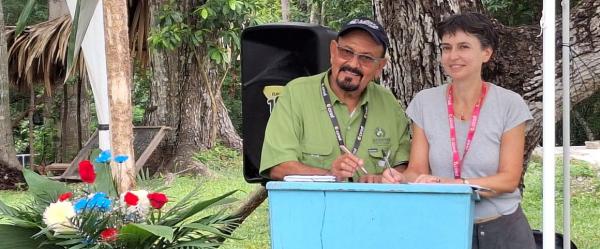Science at work 16 December 2025
- Home
- Press area
- Press releases
- discovery wild coffee species
Specialist tasters assess forgotten wild coffee species

A novel coffee tasting session was held at CIRAD’s sensorial analysis laboratory on 10 December 2020 © C. Cornu, CIRAD
The genus Coffea comprises more than 124 species, just two of which regularly turn up in our coffee cups: Arabica and Robusta. To broaden the range and make the coffee value chain more resilient, specialists at CIRAD are looking into forgotten coffee species that could be used to breed new varieties.
Diversifying coffee production is a pressing issue
Arabica is currently the most widely cultivated species. It is particularly appreciated for its sensory characteristics, which are better than those of Robusta, but entails higher production costs, requires lower temperatures, and above all has limited genetic diversity , which makes it sensitive to climate change and diseases.
One of the first ideas put forward by CIRAD was to develop new Arabica hybrids that could be grown in agroforestry systems. This solution, developed through the EU BREEDCAFS project, could partly protect Arabica against increased temperatures and water shortages.
To go further, the CIRAD team decided to look into the diversity of the genus Coffea within the collection held by the Coffea biological resource centre (see box). Three wild coffee species caught their eye:
- Coffea stenophylla , which could adapt to higher temperatures and and appears to have good gustatory quality (1),
- Coffea brevipes and Coffea congensis , which are more vigorous and could rival Robusta in terms of taste.
All three species are also apparently resistant to coffee leaf rust, a widespread disease throughout the coffee production zone.
Coffea stenophylla, which has black cherries, is a species that has almost completely died out (it is on the IUCN Red List of Threatened Species) © E. Couturon, IRD
Tasting unknown coffees
These new coffees, prepared and roasted at CIRAD, were tested on 10 December by a jury of twelve coffee tasters, including "noses" from Jacobs Douwe Egberts, Nespresso, Starbucks, Supremo, AST Sensory Skills, l’Arbre à Café, La Claque, and Belco. Of the twelve, eight were actually at CIRAD (while respecting social distancing) and four took part remotely.
The three species were each roasted three different ways, to ensure that the coffee expressed all of its aroma potential © C. Cornu, CIRAD
"Adopting new species for general consumption is not a trivial undertaking. First of all, science has to demonstrate their merits in terms of productivity and quality. The next step is ensuring that industry and consumers take them on board", says Benoît Bertrand, a breeder at CIRAD and Coffee Value Chain Correspondent. This blind tasting session was intended to lift the first barrier: demonstrating that the species correspond to consumer tastes
The blind tasting session in CIRAD's sensory analysis laboratory followed a strict protocol. The red light was to mask the different colours of the coffee, to ensure that the tasters focused on their sense of smell and taste © C. Cornu, CIRAD
"The aim of the session was to assess the gustatory quality of these new species, to see whether they correspond to consumer tastes", CIRAD researcher Delphine Mieulet explains. "If the results are conclusive, the next step will be to assess their agronomic merits."
"We could then think about crossing Coffea canephora (Robusta) and Coffea congensis or C. brevipes, to create new, more robust and higher-yielding varieties and improve quality" , she adds.
Very enthusiastic initial reactions
The full analysis of the results will be published within the next few months. However, all the tasters agreed that this was a "historic" moment.
"The aroma profile of new coffees looks promising", says Morgane Daeschner. This Q-grader (an internationally recognized professional credential that confirms the holder's ability to grade and score coffees), who trained as an agronomist, identified hints of elderflower and lychee in one of the new species.
For Hippolyte Courty, founder of l’Arbre à Café, this was an "amazing" experience. The master roaster also found hints of elderflower in one of the coffees.
Lastly, Angel Barrera, from the importer Belco, thought that the species tasted had all the necessary gustatory qualities to be launched on the market.
It is now up to CIRAD's researchers to demonstrate the agronomic merits of these new species.
The Coffea BRC, a biological resource centre devoted to wild coffee species The Coffea BRC holds 35 coffee species (genus Coffea ), primarily from Africa, in a seed vault hosted by IRD in Montpellier, and a field collection in the South of Réunion Island, on land owned by CIRAD. The collection of more than 700 genotypes is managed jointly by IRD (DIADE research unit) and CIRAD (PVBMT research unit). It is the fruit of numerous survey campaigns in Africa (Cameroon, Central African Republic, Ethiopia, Guinea, Ivory Coast, Kenya, Republic of Congo and Tanzania) and the Indian Ocean islands (Mauritius, Mayotte and Réunion). More about the Coffea BRC (in French) |
Find out more about these species
(1) Aaron P. Davis. 2020. Lost and Found: Coffea stenophylla and C. affinis , the Forgotten Coffee Crop Species of West Africa. Front. Plant Sci.



























